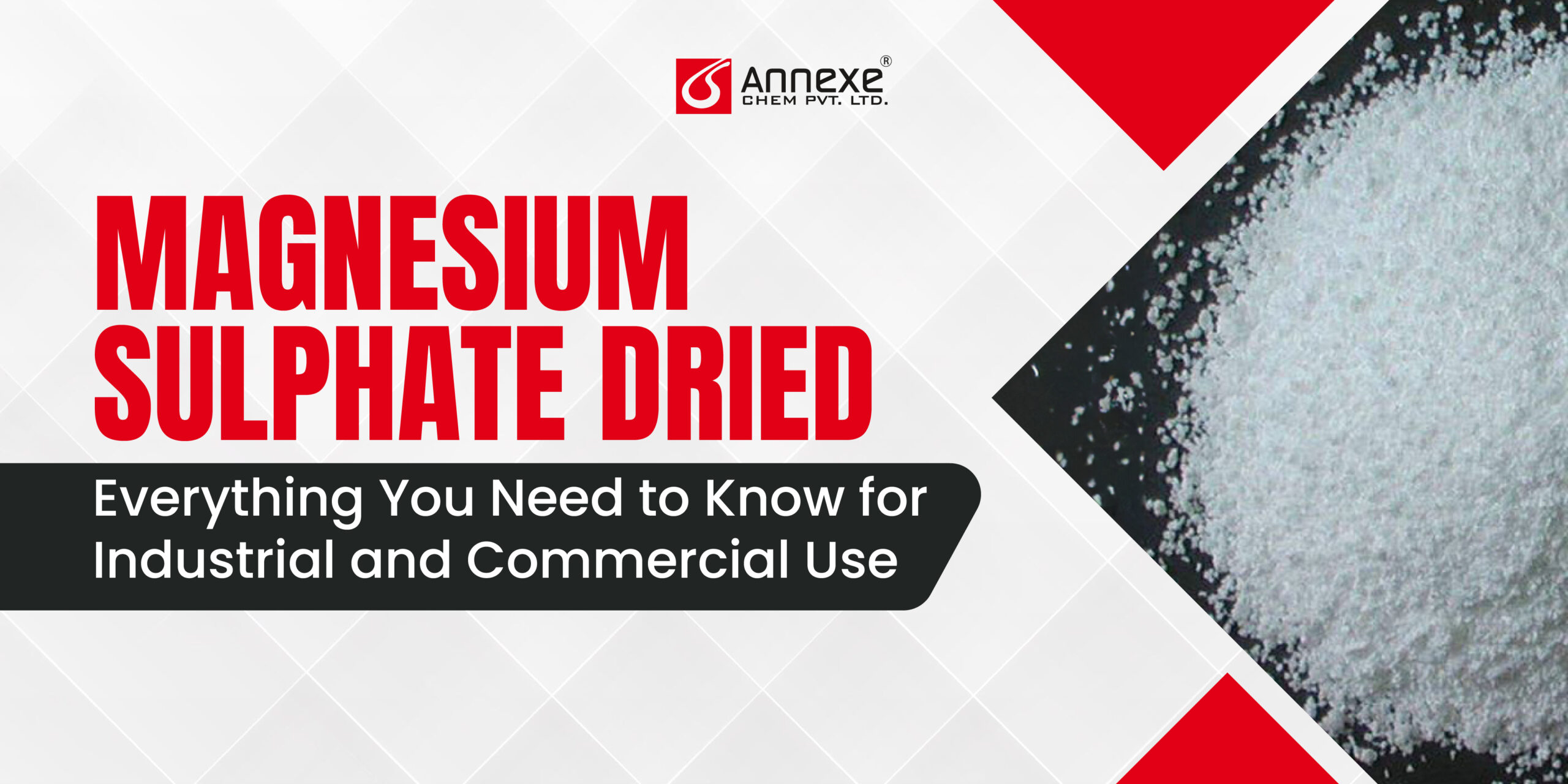Sodium Dihydrogen Phosphate: Uses, Benefits & Properties
What is Sodium Dihydrogen Phosphate? A Comprehensive Guide to Its Uses and Importance

- October 16, 2024
- By Akshita Patel
Have you ever wondered about the hidden heroes in our everyday products? One such unsung champion is sodium dihydrogen phosphate. While its name may not roll off the tongue, this powerful compound plays a pivotal role behind the scenes, impacting everything from the food on your plate to the medicines that keep you healthy. Imagine biting into a perfectly creamy cheese or enjoying a garden-fresh tomato that bursts with flavor. Sodium dihydrogen phosphate is often at work, ensuring that these delights are delicious but also safe and nutritious. This versatile compound is a master of many trades—acting as an emulsifier in foods, a vital nutrient in fertilizers, and a stabilizing agent in pharmaceuticals.
This blog will uncover the fascinating world of sodium dihydrogen phosphate. We’ll explore its essential properties, diverse applications, and why it matters more than you might think. Let’s dive in and discover how this remarkable compound shapes our world!
Definition of Sodium Dihydrogen Phosphate
Sodium dihydrogen phosphate is an inorganic compound comprised of sodium, hydrogen, and phosphate ions. It typically appears as a white, crystalline powder that is highly soluble in water, often found in its dihydrate form (NaH₂PO₄·2H₂O), which includes two water molecules that enhance its solubility and usability.
This compound is renowned for its buffering properties, allowing it to maintain stable pH levels in various solutions. Sodium dihydrogen phosphate is widely used across multiple industries due to its multifunctional capabilities, making it a crucial ingredient in food production, agriculture, and pharmaceuticals. Its ability to act as an emulsifier, nutrient source, and stabilizer highlights its versatility and importance in everyday products and specialized applications.
Chemical Properties of Sodium Dihydrogen Phosphate
Sodium dihydrogen phosphate (NaH₂PO₄) consists of one sodium ion (Na⁺), two hydrogen ions (H⁺), and one phosphate ion (PO₄³⁻). The phosphate ion has a tetrahedral structure with a central phosphorus atom surrounded by four oxygen atoms, two of which are bonded to hydrogen. This ionic composition contributes to its solubility and functionality in various applications.
Physical Properties of Sodium Dihydrogen Phosphate
- Appearance: It is a white, crystalline powder, easily blended with other substances.
- Solubility: Highly soluble in water, with solubility increasing at higher temperatures, making it effective as a buffering agent.
- Stability: Exhibits good thermal stability but should be stored in a cool, dry place to prevent moisture absorption.
These properties enhance sodium dihydrogen phosphate’s versatility in industries such as food, agriculture, and pharmaceuticals.
Applications of Sodium Dihydrogen Phosphate
Sodium dihydrogen phosphate is a versatile compound that serves various essential functions across multiple industries. Its unique chemical properties make it invaluable in food production, agriculture, pharmaceuticals, and more. Below is an in-depth look at its applications.
Applications of Sodium Dihydrogen Phosphate In the Food Industry
Sodium dihydrogen phosphate is widely used in the food industry as a food additive, identified as E339. Its key roles include:
- Emulsifier: This compound helps stabilize emulsions, which are mixtures of oil and water that usually separate. In products such as processed cheese, salad dressings, and sauces, sodium dihydrogen phosphate prevents separation, resulting in a consistent texture and improved mouthfeel. This is crucial for maintaining the quality and appeal of processed food items.
- pH Control Agent: Sodium dihydrogen phosphate is effective at regulating acidity levels in food products. It acts to stabilize pH, which is vital for preserving flavor and ensuring food safety. For example, in products like pickles and marinades, maintaining the right pH not only enhances taste but also inhibits the growth of harmful bacteria, extending shelf life.
- Nutritional Enhancer: As a source of phosphorus, this compound enriches the nutritional profile of food products. Phosphorus is an essential nutrient that plays a vital role in energy metabolism, bone health, and cellular function, making sodium dihydrogen phosphate beneficial for enhancing the nutritional value of various processed foods.
Applications of Sodium Dihydrogen Phosphate In Agriculture
In the agricultural sector, sodium dihydrogen phosphate is recognized for its dual role as a fertilizer and soil amendment:
- Fertilizer: Sodium dihydrogen phosphate is a readily available source of phosphorus, an essential macronutrient for plant growth. It promotes robust root development, flowering, and fruiting, which are critical stages in crop production. The availability of phosphorus enhances the plant’s ability to uptake other nutrients, leading to improved overall health and yield.
- Soil Amendment: Beyond its role as a fertilizer, sodium dihydrogen phosphate improves soil fertility by enhancing nutrient availability and promoting beneficial microbial activity. It can help adjust soil pH and improve the physical structure of the soil, making it more conducive to plant growth. This is particularly beneficial in soils that are deficient in phosphorus, ensuring that crops receive the necessary nutrients for optimal growth.
Applications of Sodium Dihydrogen Phosphate In Pharmaceuticals
Sodium dihydrogen phosphate is an important ingredient in the pharmaceutical industry, where it serves several critical functions:
- Drug Formulations: In pharmaceutical formulations, sodium dihydrogen phosphate is used to stabilize active ingredients. It ensures that drugs maintain their potency and effectiveness throughout their shelf life. By preventing degradation, it plays a key role in ensuring that medications are safe and effective for consumers.
- Buffering Agent: Its ability to maintain a stable pH is crucial in many drug formulations. Sodium dihydrogen phosphate buffers help create an optimal environment for the drug, enhancing its solubility and absorption in the body. This is particularly important for injectable medications and oral solutions, where pH stability can significantly impact drug efficacy.
- Electrolyte Solutions: Sodium dihydrogen phosphate is commonly included in oral rehydration solutions, which are essential for restoring electrolyte balance in patients suffering from dehydration due to illness or heat exposure. These solutions aid in rapid recovery, making this compound vital in clinical settings.
Other Uses of Sodium Dihydrogen Phosphate
Beyond its major applications, sodium dihydrogen phosphate has several additional uses in various industries:
- Cleaning Agents: In the cleaning industry, sodium dihydrogen phosphate is utilized as a pH buffer in detergents and cleaning products. It enhances the effectiveness of cleaning agents by optimizing their performance, particularly in hard water conditions. Its ability to bind with calcium and magnesium ions helps prevent soap scum, improving overall cleaning efficiency.
- Dental Products: This compound is found in certain toothpaste formulations and mouthwashes due to its ability to adjust pH levels. It helps create an environment that prevents tooth decay and supports oral health. Its buffering action helps neutralize acids produced by bacteria in the mouth, reducing the risk of cavities and promoting healthier teeth.
- Laboratory Applications: In scientific research, sodium dihydrogen phosphate is frequently used as a reagent and in buffer solutions for various biochemical assays. Its capacity to maintain stable pH levels is crucial for experiments involving enzymes, DNA, and other biological molecules, where pH can significantly affect reactions.
Future Trends: Emerging Uses and Research in Sodium Dihydrogen Phosphate
As industries evolve and the demand for innovative solutions grows, sodium dihydrogen phosphate is poised to play an increasingly significant role in various sectors. Here are some future trends and emerging uses based on current research and industry developments:
- Eco-Friendly Fertilizers: Research is focusing on its use in sustainable fertilizers to enhance nutrient uptake and reduce synthetic fertilizer reliance.
- Functional Foods: Sodium dihydrogen phosphate may be used to fortify plant-based products and functional beverages, supporting bone health and energy metabolism.
- Stability in Formulations: Its buffering capabilities are being studied for stabilizing proteins and nucleic acids in biologics and biosimilars.
- Eco-Friendly Cleaners: Sodium dihydrogen phosphate could serve as a biodegradable ingredient in sustainable cleaning formulations.
- Targeted Drug Delivery: Research is exploring its potential in developing nanocarriers for precise pharmaceutical delivery.
- Water Treatment: Its properties may enhance the efficiency of wastewater treatment processes.
- Biochemical Pathways: Studies are ongoing to better understand its role in enzyme reactions, potentially leading to new scientific breakthroughs.
As we look to the future, emerging trends highlight the potential for sodium dihydrogen phosphate to contribute to sustainable agricultural practices, health-focused food innovations, and advanced pharmaceutical formulations. Ongoing research continues to explore its versatility, suggesting that its applications may expand even further in the coming years.
Annexe Chem Pvt Ltd is a leading manufacturer of sodium dihydrogen phosphate, and its success is rooted in a wide range of quality products produced in a state-of-the-art FDA-GMP facility. The company is known for offering competitive prices and timely deliveries through a well-established distribution network. Additionally, Annexe Chem takes great care in packaging their products using advanced technology to preserve their integrity.
By understanding and leveraging the benefits of sodium dihydrogen phosphate, industries can improve their products while aligning with the growing demand for sustainable and health-oriented solutions. This compound stands as a testament to the profound impact that chemistry has on daily life and the continuous pursuit of innovation in a rapidly changing world.

Akshita Patel
As an advocate for sustainability, Akshita is committed to driving positive change within the chemical industry. She actively seeks out environmentally friendly solutions and promotes the adoption of sustainable practices. Akshita believes that a balance between economic growth and ecological responsibility is crucial for the industry's long-term success. She is dedicated to finding innovative ways to minimize environmental impact while maximizing efficiency and profitability.
Related Blogs

- September 10, 2024
- By Akshita Patel
Magnesium Sulphate Dried: Everything You Need.
Chemical Composition and Structure Of Magnesium Sulphate Dried In the world of fine chemicals, Magnesium Sulphate.

- October 23, 2024
- By Akshita Patel
Why Mono Potassium Phosphate Is a.
In the world of agriculture, gardening, and even the food industry, there’s a powerful yet often.



